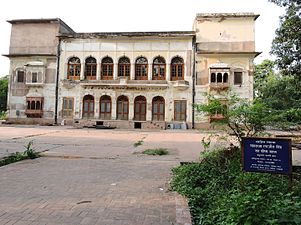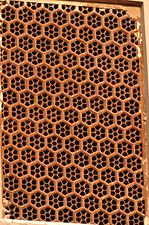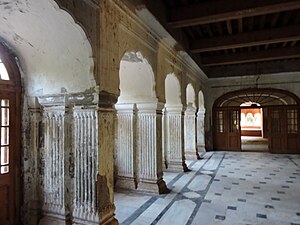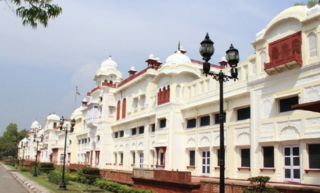
Patiala is a city in southeastern Punjab, northwestern India. It is the fourth largest city in the state and is the administrative capital of Patiala district. Patiala is located around the Qila Mubarak constructed by the Sidhu Jat chieftain Ala Singh, who founded the royal dynasty of Patiala State in 1763, and after whom the city is named.

Amritsar, historically also known as Rāmdāspur and colloquially as Ambarsar, is the second largest city in the Indian state of Punjab, after Ludhiana. It is a major cultural and economic centre located in the Majha region of Punjab. The city is the administrative headquarters of the Amritsar district.

Maharaja Ranjit Singh, popularly known as Sher-e-Punjab or "Lion of Punjab", was the first Maharaja of the Sikh Empire, which ruled the northwest Indian subcontinent in the early half of the 19th century. He survived smallpox in infancy but lost sight in his left eye. He fought his first battle alongside his father at age 10. After his father died, he fought several wars to expel the Afghans in his teenage years and was proclaimed as the "Maharaja of Punjab" at age 21. His empire grew in the Punjab region under his leadership through 1839.

The Samadhi of Ranjit Singh is a 19th-century building in Lahore, Pakistan that houses the funerary urns of the Sikh Maharaja Ranjit Singh. It is located adjacent the Lahore Fort and Badshahi Mosque, as well the Gurdwara Dera Sahib which marks the spot where the 5th guru of Sikhism, Guru Arjan Dev, died. Its construction was started by his son and successor Maharaja Kharak Singh after the ruler's death in 1839, and completed nine years later. It overlooks the Hazuri Bagh, which was built by Ranjit Singh, to its south.

Hazuri Bagh is a garden in Lahore, Punjab, Pakistan, bounded by the Lahore Fort to the east, Badshahi Mosque to the west, the Samadhi of Ranjit Singh to the north, and the Roshnai Gate to the south. The garden was built during the reign of Maharaja Ranjit Singh. In the centre of the park stands the Hazuri Bagh Baradari, built by the Maharaja in 1818 to celebrate his capture of the Koh-i-Noor diamond from Shuja Shah Durrani in 1813. The Serai Alamgiri caravanserai formerly stood where Hazuri Bagh is now located.

The Hazuri Bagh Baradari is a baradari of white marble located in the Hazuri Bagh of Lahore, Pakistan. It was built by Maharaja Ranjit Singh, the Sikh ruler of Punjab to celebrate his capture of the Koh-i-Noor diamond from Shuja Shah Durrani in 1813. Its construction was completed in 1818.

The Lahore Fort is a citadel in the city of Lahore, Punjab, Pakistan. The fortress is located at the northern end of walled city Lahore, and spreads over an area greater than 20 hectares. It contains 21 notable monuments, some of which date to the era of Emperor Akbar. The Lahore Fort is notable for having been almost entirely rebuilt in the 17th century, when the Mughal Empire was at the height of its splendour and opulence.
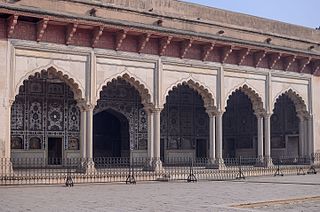
The Sheesh Mahal is located within the Shah Burj block in northern-western corner of Lahore Fort. It was constructed under the reign of Mughal Emperor Shah Jahan in 1631–32, with some additions later under Sikh Maharaja Ranjit Singh. The ornate white marble pavilion is inlaid with pietra dura and complex mirror-work of the finest quality. The hall was reserved for personal use by the imperial family and close aides. It is among the 21 monuments that were built by successive Mughal emperors inside Lahore Fort, and forms the "jewel in the Fort’s crown." As part of the larger Lahore Fort Complex, it has been inscribed as a UNESCO World Heritage Site since 1981.

The Architecture of Lahore reflects the history of Lahore and is remarkable for its variety and uniqueness. There are buildings left from the centuries of rule of the Mughal Empire, the Sikh Empire, as well as from the era of the British Raj, whose style is a mixture of Victorian and Islamic architecture often referred to as Indo-Saracenic. In addition, there are newer buildings which are very modern in their design. Unlike the emphasis on functional architecture in the west, much of Lahore's architecture has always been about making a statement as much as anything else.
The Sukerchakia Misl was one of 12 Sikh Misls in Punjab during the 18th century concentrated in Gujranwala and Hafizabad district in Western Punjab and ruled from (1752-1801). Misl was founded by Chaudhary Charat Singh a Jat of Sandhawalia and grandfather of Maharaja Ranjit Singh. The Sukerchakia last Misldar was Maharaja Ranjit Singh. Towards the end of the eighteenth century, Maharaja Ranjit Singh united all the Misls and established an independent Sikh Empire.
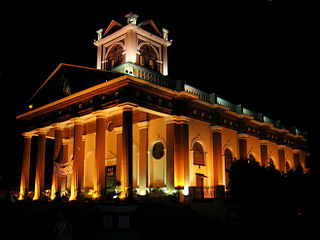
Kapurthala is a city in Punjab state of India. It is the administrative headquarters of Kapurthala District. It was the capital of the Kapurthala State, a princely state in British India. The secular and aesthetic mix of the city with its prominent buildings based on French and Indo-Saracenic architecture self-narrate its princely past. It is also known as city of Palaces & Gardens. According to the 2011 Census, Kapurthala is the least populated city in India.

The Sikh Empire was a state originating in the Indian subcontinent, formed under the leadership of Maharaja Ranjit Singh, who established an empire based in the Punjab. The empire existed from 1799, when Maharaja Ranjit Singh captured Lahore, to 1849, when it was defeated and conquered in Second Anglo-Sikh War. It was forged on the foundations of the Khalsa from a collection of autonomous Sikh misls. At its peak in the 19th century, the Empire extended from the Khyber Pass in the west to western Tibet in the east, and from Mithankot in the south to Kashmir in the north. Religiously diverse, with an estimated population of 3.5 million in 1831, it was the last major region of the Indian subcontinent to be annexed by the British Empire.
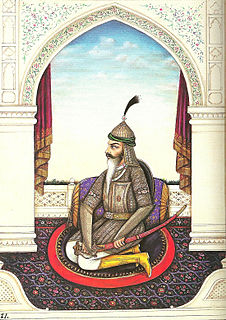
Hari Singh Nalwa (1791–1837) was Commander-in-chief of the Sikh Khalsa Fauj, the army of the Sikh Empire. He is known for his role in the conquests of Kasur, Sialkot, Attock, Multan, Kashmir, Peshawar and Jamrud. Hari Singh Nalwa was responsible for expanding the frontier of Sikh Empire to beyond the Indus River right up to the mouth of the Khyber Pass. At the time of his death, the western boundary of the empire was Jamrud.

Majha is a region located in the central parts of the historical Punjab region split between India and Pakistan. It extends north from the right banks of the river Beas, and reaches as far north as the river Jhelum. People of the Majha region are given the demonym "Mājhī", however some people who belong to the this region use Majhail too. Most inhabitants of the region speak the Majhi dialect, which is the basis of the standard register of the Punjabi language. The most populous city in the area is Lahore on the Pakistani side and Amritsar on the Indian side of the border.
The Sikhs are adherents to Sikhism the fifth largest organized religion in the world, with around 25 million adherents. Sikh History is around 500 years and in that time the Sikhs have developed unique expressions of art and culture which are influenced by their faith and synthesize traditions from many other cultures depending on the locality of the adherents of the religion. Sikhism is the only religion that originated in the Punjab region with all other religions coming from outside Punjab. All the Sikh gurus, many saints and many of the martyrs in Sikh history were from Punjab and from the Punjabi people. Punjabi culture and Sikhism are mistakenly considered inseparably intertwined. "Sikh" properly refers to adherents of Sikhism as a religion, strictly not an ethnic group. However, because Sikhism has seldom sought converts, most Sikhs share strong ethno-religious ties as therefore it's a common stereotype that all Sikhs share the same ethnicity. Many countries, such as the U.K., therefore misconcievingly recognize Sikh as a designated ethnicity on their censuses. The American non-profit organization United Sikhs has fought to have Sikh included on the U.S. census as well, arguing that Sikhs "self-identify as an 'ethnic minority'" and believe "that they are more than just a religion".

Moti Bagh Palace is a palace in Patiala, also known as Pearl Garden Palace. The word "Moti" means "pearl", and "Bagh" means "garden". The Palace was built by Maharaja Narinder Singh, the great-grandfather of Maharaja Bhupinder Singh, in 1847, at a cost of five lakhs of rupees. The Old Moti Bagh Palace and New Moti Bagh Palace were built respectively by Maharaja Narinder Singh and Maharaja Yadavindra Singh.

Kharak Singh was the second Maharaja of the Sikh Empire. He was the eldest son of Maharaja Ranjit Singh, founder of the Sikh Empire and his consort, Maharani Datar Kaur. He succeeded his father on 27 June 1839 and reigned until his dethronement and imprisonment on 8 October 1839. He was succeeded by his only son Nau Nihal Singh.
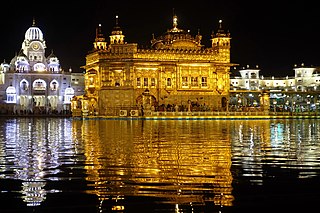
The Golden Temple is a gurdwara located in the city of Amritsar, Punjab, India. It is the preeminent spiritual site of Sikhism.
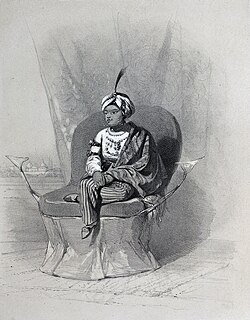
The Sikh Rule in Lahore initiated from the invasion and rule of the Sikh Misls and extended till the Sikh Empire of Ranjit Singh which ended in 1849. The Sikhs began gaining power following the decline of the Mughal Empire in Punjab and consisted of a collection of autonomous Punjabi Misls, which were governed by Misldars, mainly in the Punjab region.
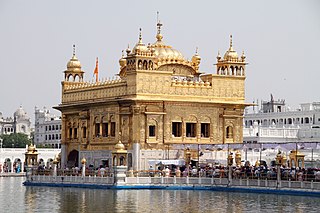
The state of Punjab is renowned for its cuisine, culture and history. Punjab has a vast public transportation and communication network. Some of the main cities in Punjab are Amritsar, Ludhiana, Jalandhar, Patiala, Mohali, Bathinda, Firozpur and Pathankot. Patiala is known for its historical forts. Punjab also has a rich Sikh religious history.




